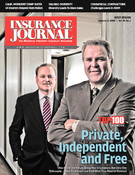Navigating the Valuation Quagmire
As the saying goes, the devil is in the details. And insurance agents would be wise to explain the differences between actual cash value (ACV) and replacement cost value (RCV) to customers. Homeowners’ and commercial property policies typically provide that the insurer is not required to pay more than the ACV of the damaged property until the repair or replaced is completed. The typical policy does not, however, address all of the issues that could arise in determining the measure of recovery for a loss and when the insured can recover on a RCV basis.
Although property policies provide for payment of “actual cash value,” they are conspicuously silent on how ACV should be measured. For many years, insurers argued that ACV should be measured by replacement costs less depreciation. That view was rejected by the California Supreme Court in Jefferson Ins. Co. of New York v. Superior Court (1974) 3 Cal. 3rd 398.
In Jefferson, the insured suffered a fire loss to a hotel building that had a fair market value of $65,000. The insurer and insured both agreed that the amount of the loss was $24,102.05.
The insurer, however, refused to pay that sum, contending that the property was substantially underinsured according to the “average clause” in the policy, which provided for a proportionate reduction of any loss unless the building was insured to 70 percent of its ACV. The insurer’s theory was that ACV, as used in the policy did not mean fair market value, but rather meant the replacement cost of the building less depreciation. The replacement costs less a reasonable depreciation factor was approximately $170,000.
The insured contended that the building was sufficiently insured, asserting that ACV referred to in the policy meant fair market value. The California Supreme Court agreed and held that the term ACV, as used Insurance Code Section 2071 is synonymous with “fair market value,” i.e., “the price that a willing buyer would pay to a willing seller, neither being under any compulsion to sell or buy.” (3 Cal 3rd at 402). See, also, Elliano v. Assurance Co. of America (1975) 45 Cal. App. 3rd 1170.
Under the ACV provisions of a policy, where the damaged property can be repaired, the insured is entitled only to the repair cost — not to any diminution in the property’s fair market value. For example, in Ray v. Farmer’s Ins. Exchange (1988) 200 Cal. App. 1411, a truck collided with the insured’s parked automobile. The repair estimate was approximately $4,000. At the time of the collision, the insured’s car had a market value of approximately $7,100, and after the collision, its salvage value was $1,650. The insured demanded the insurer replace the car or, alternatively, pay the difference, if any, in the car’s market value before the collision and after the repair. The issue presented to the court was whether the insurance policy provided coverage for diminution in the market value of the repaired car because of its status as a wrecked car. The California Court’s of Appeal ruled the policy unambiguously gave the insurer the right to elect to repair the vehicle if the cost to repair to “like kind and quality” was less than the ACV at the time of the loss.
In Owens v. Pyeatt (1967) 248 Cal. App. 2nd 840, the court was confronted with the question whether the insurer’s election to repair is conclusive. The answer given by the court was yes, provided the repair places the automobile substantially in its pre-accident condition. If it does not, then the automobile is deemed a total loss and the insurer is liable for the pre-accident value of the car. Owens did not define “like kind and quality” other than to note that it means “substantially the same condition [as] before the accident.” 248 Cal. App. 2d at 849.
In Ray, supra, the insured argued that the “substantially the same condition” language used in Owens meant that the insurer was obligated to compensate the insured for any diminution in fair market value. Yet the court ruled that “like kind and quality” is not the equivalent of “ACV” at the time of the loss, and that as a practical matter one may assume that any automobile sustaining significant collision damage will lose some market value after repairs. As noted, the court in Ray, ruled that to hold the insurer liable for the automobile’s diminution in value “would render essentially meaningless [the insurer’s] clear right to elect to repair rather than to pay the actual cash value of the vehicle at the time of the loss.” (200 Cal. App. 3rd at 1417).
The fair market value analysis works fine in most cases. Leslie Salt Co. v. St. Paul Mercury Ins. Co. (9th Cir. 1981) 637 F. 2nd 65 addressed the issue when damaged property has no fair market value. The insured in that case was a salt manufacturer. Part of the manufacturing process entailed removing salt from sea water and stacking the salt for drying. Stacking was done with custom-made machine. On a test run, the stacker buckled, collapsed and was destroyed. The court held that although ACV generally means fair market value and replacement cost, that rule does not apply when the insured property, such as the custom-built stacker, has no market.
In a recent unpublished decision, a California court ruled that the insured has the burden of establishing that the damaged property constituted the type of unique property that required valuation by means of a replacement cost test. Century Surety Company v. P&S Fashions, Inc. 2007 WL 1129207. There are no published decisions addressing this issue.
An insured may not recover the costs of replacing property under the RCV policy provisions until the insured actually replaces the property. Diamond v. Ins. Co. of North America (1968) 267 Cal. App. 2nd 415. Nonetheless, most policies allow the insured to first recover on an ACV basis and later claim the RCV benefits by satisfying the conditions of coverage (e.g., repair or replacement within a specified number of days following the loss).
RCV coverage does not require the insured to replace the damaged property at the same location; an insured may recover RCV benefits for damage to his home by purchasing another home at another location. Conway v. Farmer’s Home Mut. Ins. Co. (1994) 26 Cal. App. 4th 1185.
Moreover, absent a specific policy provision, an insured is not entitled to compensation for the cost of complying with new building codes. In McCorkle v. State Farm Ins. Co. (1990) 221 Cal. App. 3rd 610, the insureds filed a lawsuit based on the insurer’s refusal to pay for the full costs of replacing a destroyed garage with one with a concrete floor, as required by modern building codes. The original garage had a wooden floor, and the insurer tendered the costs of reconstruction of the garage with the wooden floor, and refused to pay for the upgrade costs. The Courts of Appeal held that the insurer did not breach its policy obligations by refusing to pay the additional costs necessary to comply with building codes, because the loss settlement clause limited coverage to replacement using “equivalent” construction. In so ruling, the court noted that the purpose of fire insurance is “to compensate for the actual loss sustained, not to place the insured in a better position than he or she was before the fire.” (221 Cal. App. 3rd at 614-615).
Similar results were reached in Breshears v. Indiana Lumbermen’s Mut. Ins. Co. of Indianapolis, Indiana (1967) 256 Cal. App. 2nd 245, and Bischel v. Fire Ins. Exchange (1991) 1 Cal. App. 4th 1168. But insurers must make certain disclosures if a policy does not cover building code upgrades. Under Insurance Code Section 10103, insurers must furnish policyholders the statement in at least 10 point type: “THIS POLICY DOES NOT INCLUDE BUILDING CODE UPGRADE COVERAGE.”
An open issue that remains is whether an insurer is entitled to subtract depreciation and deferred maintenance costs from a loss. Several cases suggest that an insurer may not deduct such costs, at least where the policy does not clearly give the insurer the right to do so. Continental Ins. Co. v. Dunn (9th Cir. 1955) 226 Fed. 2nd 471, 473; Hughes v. Potomac Ins. Co. of District of Colombia (1962) 199 Cal. App. 2nd 239, 252.
Topics California Carriers Profit Loss Auto Property
Was this article valuable?
Here are more articles you may enjoy.


 Group Sues California Department of Insurance Over FAIR Plan Surcharges
Group Sues California Department of Insurance Over FAIR Plan Surcharges  NJ Wildfire Update: 50% Contained; High Spread Risk Today; Suspect in Custody
NJ Wildfire Update: 50% Contained; High Spread Risk Today; Suspect in Custody  USI Says Lockton, Former Team Leader Poached Workers, Harmed Client Relations
USI Says Lockton, Former Team Leader Poached Workers, Harmed Client Relations  Pet Insurance, Agents Gets a Shorter Leash Under Bill DeSantis Signed Into Law
Pet Insurance, Agents Gets a Shorter Leash Under Bill DeSantis Signed Into Law 


